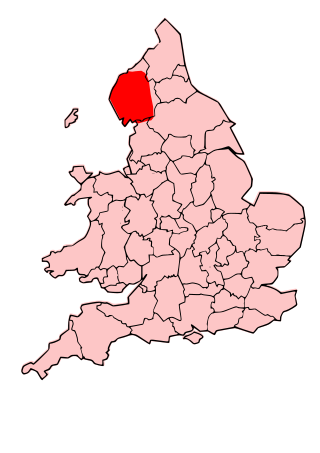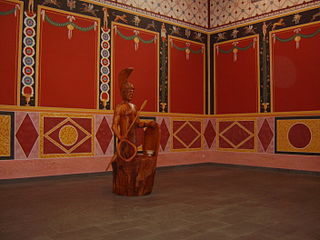Related Research Articles

In Gallo-Roman religion, Loucetios was a Gallic god known from the Rhine-Moselle region, where he was identified with the Roman Mars. Scholars have interpreted his name to mean ‘lightning’. Mars Loucetius was worshipped alongside the goddess Nemetona.

The Ligurian language was spoken in pre-Roman times and into the Roman era by an ancient people of north-western Italy and current south-eastern France known as the Ligures.

The Carvetii were a Brittonic Celtic tribe living in what is now Cumbria, in North-West England during the Iron Age, and were subsequently identified as a civitas (canton) of Roman Britain.

The Brigantes were Ancient Britons who in pre-Roman times controlled the largest section of what would become Northern England. Their territory, often referred to as Brigantia, was centred in what was later known as Yorkshire. The Greek geographer Ptolemy named the Brigantes as a people in Ireland also, where they could be found around what is now Wexford, Kilkenny and Waterford, while another people named Brigantii is mentioned by Strabo as a sub-tribe of the Vindelici in the region of the Alps.

The Eburones were a Gaulish-Germanic tribe dwelling in the northeast of Gaul, who lived north of the Ardennes in the region near that is now the southern Netherlands, eastern Belgium and the German Rhineland, in the period immediately preceding the Roman conquest of the region. Though living in Gaul, they were also described as being both Belgae and Germani.
The Volcae were a Gallic tribal confederation constituted before the raid of combined Gauls that invaded Macedonia c. 270 BC and fought the assembled Greeks at the Battle of Thermopylae in 279 BC. Tribes known by the name Volcae were found simultaneously in southern Gaul, Moravia, the Ebro valley of the Iberian Peninsula, and Galatia in Anatolia. The Volcae appear to have been part of the late La Tène material culture, and a Celtic identity has been attributed to the Volcae, based on mentions in Greek and Latin sources as well as onomastic evidence. Driven by highly mobile groups operating outside the tribal system and comprising diverse elements, the Volcae were one of the new ethnic entities formed during the Celtic military expansion at the beginning of the 3rd century BC. Collecting in the famous excursion into the Balkans, ostensibly, from the Greek point of view, to raid Delphi, a branch of the Volcae split from the main group on the way into the Balkans and joined two other tribes, the Tolistobogii and the Trocmi, to settle in central Anatolia and establish a new identity as the Galatians.

Sextus Calpurnius Agricola was a Roman senator and general active during the 2nd century. He was consul suffectus with Tiberius Claudius Julianus for the nundinium of September-October 154. Agricola is known primarily from inscriptions.

The Venetī were a Gallic tribe dwelling in Armorica, in the southern part of the Brittany Peninsula, during the Iron Age and the Roman period.
Gobannus was a Gallo-Roman smithing god.

The Petrocorii were a Gallic tribe dwelling in the present-day Périgord region, between the Dordogne and Vézère rivers, during the Iron Age and the Roman period.

Lenus was a Celtic healing god worshipped mainly in eastern Gaul, where he was almost always identified with the Roman god Mars.

Coria was a fort and town 2.5 miles (4.0 km) south of Hadrian's Wall, in the Roman province of Britannia. It was strategically located on the junction of a major Roman north–south road with the River Tyne and the Roman Stanegate road, which was also the first frontier line which ran east–west between Coria and Luguvalium. Corbridge Roman Site is in the village of Corbridge in the county of Northumberland.

The Lemovīcēs were a Gallic tribe dwelling in the modern Limousin region during the Iron Age and the Roman period.

The Ambarri were a Gallic people dwelling in the modern Ain department during the Iron Age and the Roman period.
The Latobici or Latovici were a Celtic tribe dwelling in Pannonia Superior, around present-day Drnovo (Slovenia), during the Roman period.
Toutatis or Teutates is a Celtic god who was worshipped primarily in ancient Gaul and Britain. His name means "god of the tribe", and he has been widely interpreted as a tribal protector. According to Roman writer Lucan, the Gauls offered human sacrifices to him.
The Coriondi (Κοριονδοί) were a people of early Ireland, referred to in Ptolemy's 2nd century Geography as living in southern Leinster.
The Caerosi were a small Belgic-Germanic tribe that lived in Gallia Belgica during the Iron Age and the Roman period. Their ethnic identity remains uncertain. Caesar described them as part of the Germani Cisrhenani, but their tribal name is probably of Celtic origin. Like other Germani Cisrhenani tribes, it is possible that their old Germanic endonym came to be abandoned after a tribal reorganization, that they received their names from their Celtic neighbours, or else that they were fully or partially assimilated into Celtic culture at the time of the Roman invasion of the region in 57 BC.
The Caeracates were small tribe dwelling in Gallia Belgica during the Roman period. Like the Aresaces, they were probably a sub-tribe (pagus) of the larger Treveri, since they were too small to form their own civitas.
The Catuslugi were a small Belgic coastal tribe dwelling around modern-day Incheville (Normandy) during the Roman period.
References
- ↑ Roman Inscriptions of Britain: RIB 1142. Altar dedicated by Quintus Calpurnius Concessinius
- ↑ Shotter 2012, p. 49: "We hear, too, of the annihilation of a band of Corionototae (possibly a Brigantian sub-group who lived near Corbridge)."
- 1 2 Waldman, Carl; Mason, Catherine (2006). Encyclopedia of European Peoples. Infobase Publishing. p. 177. ISBN 978-1-4381-2918-1.
- ↑ Delamarre 2003, pp. 125–126.
- 1 2 Charles-Edwards 1974.
- ↑ David Mattingly, An Imperial Possession: Britain in the Roman Empire, Penguin (2007)
Bibliography
- Charles-Edwards, T.M. (1974). "Native Political Organisation in Roman Britain and the Origin of Middle Welsh Brenhin". In Mayrhofer, Manfred (ed.). Antiquitates Indogermanicae. Institute für Sprachwissenschaft der Universitat Innsbruck. pp. 35–45. ISBN 978-3851245202.
- Delamarre, Xavier (2003). Dictionnaire de la langue gauloise: Une approche linguistique du vieux-celtique continental. Errance. ISBN 9782877723695.
- Shotter, David (2012). Roman Britain. Routledge. ISBN 978-1-134-70773-7.